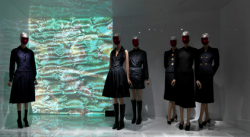Art of The Ugly
Monday, July 09, 2012
One of the best pieces I’ve read about the latest Costume Institute
exhibit at the Metropolitan Museum, “Prada & Schiaparelli,†is in this week’s issue of City Arts. Read here: http://cityarts.info/2012/06/12/ugly-chic-the-couture-version/

Prada’s avowed heroes, Bunuel and Antonioni (among my heroes too, by the way), may also have held the striving rich at an emotional distance, and may also have pushed the limits of propriety. But their attempts to air-out the staleness of an insulated and over-protected world moved their culture forward. They led, they shared, they opened windows with their art. I can’t imagine what they would make of Miuccia, who has perverted what may indeed be considerable gifts of talent and intellect to create gestures no greater than a mocking smirk. What’s particularly irritating is that Prada, who was born into a privledged family, has become even more fabulously wealthy by doing exactly that. Sneering. Far richer than Bunuel or Antonioni or, for that matter – Schiaparelli.
Unlike Prada, Schiaparelli’s genius, like that of her fellow Surrealists, lay in the liberating nature of imagination, and their belief in a movement that suggested mankind might prosper in its freedom. Schiap’s ability to weave iconoclastic ideas into garments that also made one think (or at least smile) came from an idea that style and art were not removed from one another, not mutually exclusive concepts.
The fact that the eye can only be renewed by challenge, and that challenge is sometimes interpreted as ugly, may be true, but it only works so far. Schiaparelli’s clothes were witty and sometimes outrageous – but they were, nearly always, beautiful. And even when she’s making the point of challenging our concept of adornment, her proof is in the absolute. It may be a lobster of the scale and color you’d find in a seaside clam bar; you may never have imagined it rendered in seed pearls and sequins – but there it is. It should be tacky. It should be terrible. But it is, impossibly, undeniably - beautiful.
The City Arts piece suggests that Schiap meant to lampoon the upper crust of England and Europe by dressing them in outrageous garb while the carnage of World War 2 fell about them. The irony may not have been lost on her, but I very much doubt it was her aim. The Surrealists were far beyond mere cultural comment. The life of the mind, the idea of art as part of the revolution of imagination, fueled the Surrealists – from Apollinaire to Leonor Fini to Schiaparelli. By juxtaposing objects, stripping them of their normal or apparently defined significance, one could release something powerful and unconscious that might come closer to the natural, uncorrupted spirit one might call freedom. Magritte, Ernst, deChirico. It’s an Art with a mission.
The fact that Elsa Schiaparelli’s art was hung on shoulders, rather than museum walls, is to me, a slender difference. Like the ancient gold and jeweled cuffs and crowns of primitive warriors, the fact of adornment as art, almost makes the point of art that much more powerful. I was so excited to see that she was to be honored by the Met, and so very disappointed in the pairing of her work with a designer whose greatest talent lies in the art of the sneer. (0) Comments •
